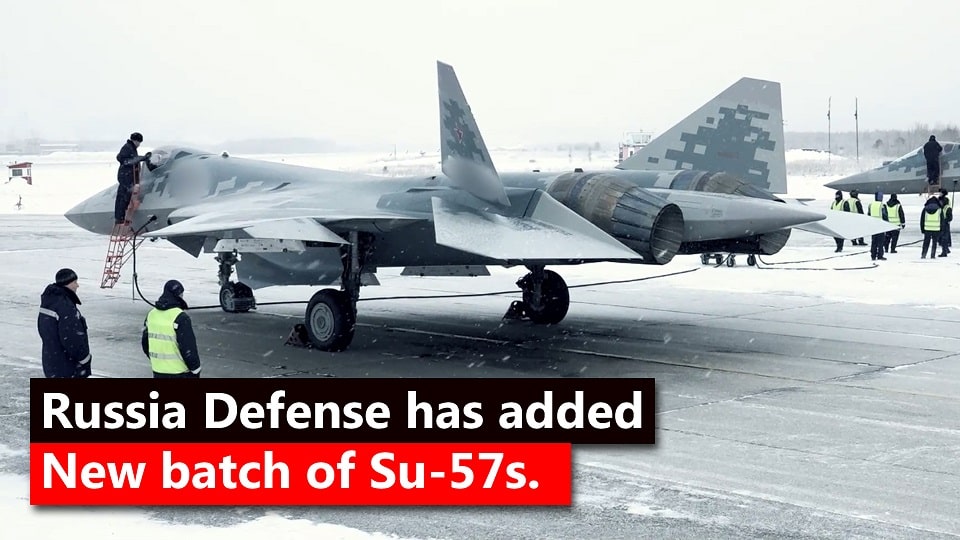Aerospace
Sukhoi handed the brand-new SU-57 fighter jet to the Russian defence in the midst of the Ukraine crisis.

The new Sukhoi 57 fighter jets have been delivered by United Aircraft Corporation of Russia to its national Air force defence. according to the official press release from earlier.
The manufacturer said that the Su-57 and versatile Su-35S fighters for the Russian Aerospace Forces had been produced according to schedule at the aircraft facility for the current year. It will keep up with its responsibilities. The aeroplane is already in production and will be delivered the following year.
Sikorsky Delivers S-92® Helicopter To Korea Coast Guard(Opens in a new browser tab)
Serial deliveries for the Su-57 began in 2022. The Russian defence ministry will buy 22 fighters by the end of 2024, and 76 fighters by the end of 2028. Russian Aircraft Corporation and Sukhoi Design Bureau are working on the fifth-generation Su-57. It is made to destroy various surface, ground, and aerial targets.
The aircraft is equipped with contemporary onboard technology, a supersonic cruising speed, in-fuselage weaponry, a radio-absorbing coating, and more. The fighter’s exceptional mobility and supersonic cruise capability are believed to give it an advantage in close-quarters combat situations.
The UAC has currently built 21 aircraft out of the 11 that are currently in service for defence. Let’s analyze the Su 57 fighter’s 5 features.
- A fifth-generation stealth multirole fighter aircraft designed by Sukhoi is the Sukhoi Su-57. It is the first stealth-technology-designed aircraft in Russian military service. The Su-57 is outfitted with a variety of air-to-air and air-to-ground missiles and boasts cutting-edge avionics, including as an active electronically scanned array radar and an infrared search and track system.
- The Su-57 had its first flight in 2010, and the general public first saw it in 2017. It was the first fifth-generation fighter aircraft used by the Russian Air Force when it entered Russian military service in 2020.The Su-57 had a 3,530 km range and a top speed of 1,600 km/h (990 mph) (2,190 mi). It has two Saturn AL-41F1S engines and a takeoff weight of 34,500 kg (76,060 lb).
- The Su-57 has seen a number of development setbacks, and Russia has been debating whether to produce and use it in the future. The Russian military, however, has expressed confidence in the aircraft and its skills, and it is anticipated that the aircraft will play a significant part in the nation’s future air defence and offensive capabilities.

Aerospace
Boeing Transfers Rocket Stage to NASA, Paving Way for Human Moon Mission

Boeing has achieved a significant milestone by providing NASA with the second core stage of the Space Launch System (SLS) rocket.
This crucial component, crafted at NASA’s Michoud Assembly Facility (MAF), is set to propel the Artemis II crew into lunar orbit, marking humanity’s return to deep space after a 50-year hiatus.
The monumental Boeing-built rocket stage, the largest element of the Artemis II mission, will embark on a journey aboard the Pegasus barge, traveling 900 miles to NASA’s Kennedy Space Center.
Comparison of two legendary aircraft B777x vs B747 aircraft:Click here
Upon arrival, it will be meticulously integrated with other essential Artemis II components, including the upper stage, solid rocket boosters, and NASA’s Orion spacecraft within the iconic Vehicle Assembly Building. This intricate integration process is a vital step toward the eagerly anticipated Artemis II launch, slated for 2025.
“Boeing-built products helped land humankind on the moon in 1969, and we’re proud to continue that legacy through the Artemis generation,” remarked Dave Dutcher, vice president and program manager for Boeing’s SLS program. “Together, with NASA and our industry partners and suppliers, we are building the world’s most capable rocket and paving the way to deep space through America’s rocket factory in New Orleans.”
NASA, Lockheed Martin Reveal X-59 Quiet Supersonic Aircraft:Click here
The delivery of Core Stage 2 marks a significant achievement in the evolution of the SLS rocket. Towering over 200 feet and powered by four RS-25 engines, this core stage, coupled with two solid-fueled booster rockets, will generate a staggering 8.8 million pounds of thrust. This immense power is crucial to launching Artemis II and future missions into the vast expanse of space.
The SLS rocket stands unparalleled in its capability to transport both crew and substantial cargo to the moon and beyond in a single launch. Its extraordinary capacity will facilitate the delivery of human-rated spacecraft, habitats, and scientific missions to destinations including the moon and Mars, ushering in a new era of space exploration.
-

 Travel1 week ago
Travel1 week agoAir India to Expand US Operations with Three New Routes After a Decade
-

 Travel2 weeks ago
Travel2 weeks agoWhy We Should Avoid These Stamps in a Passport
-

 Airlines1 month ago
Airlines1 month agoInvestigations Reveal Fake Chinese Titanium in Boeing and Airbus Jets
-

 Tech4 weeks ago
Tech4 weeks agoChina’s CATL Plans 1,800-Mile Electric Plane Launch by 2027
-

 Airport3 days ago
Airport3 days agoTop 10 Largest Airports in the World by Size
-

 Aerospace4 weeks ago
Aerospace4 weeks agoChina’s Fighter Jets Turn Wings into Autonomous Drones
-

 Airlines4 days ago
Airlines4 days agoAir India Rolls Out A350s for Delhi-New York JFK and Newark Routes
-

 Defence3 weeks ago
Defence3 weeks agoBoeing Enhances Chinook with New Engines and Block II Upgrades at $96 Million







